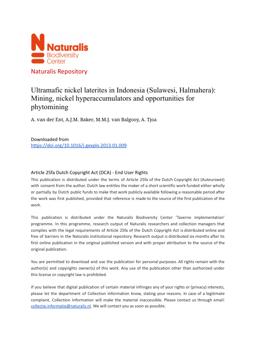2013-01-26
Ultramafic nickel laterites in Indonesia (Sulawesi, Halmahera): Mining, nickel hyperaccumulators and opportunities for phytomining
Publication
Publication
Journal of Geochemical Exploration , Volume 128 p. 72- 79
Indonesia (Sulawesi and Halmahera Islands) has some of the largest surface exposures of ultramafic bedrock in the world, and these are the sites of productive lateritic nickel mining operations. The proven and potential use of native plant species of ultramafic outcrops in mine rehabilitation can help drive conservation efforts, and nickel hyperaccumulators in particular can potentially be used in phytomining. The phytomining operation uses hyperaccumulators to extract residual nickel from stripped land. As such, in the foreseeable future, implementation of this technology is likely to be seen as a part of a progressive rehabilitation strategy of lateritic nickel mining in Indonesia. This approach ensures effective erosion control (e.g. ‘re-greening’) while at the same time generating income by gaining residual nickel.
| Additional Metadata | |
|---|---|
| , , , , , | |
| doi.org/10.1016/j.gexplo.2013.01.009 | |
| Journal of Geochemical Exploration | |
| Organisation | Staff publications |
|
van der Ent, A., Baker, A.J.M., van Balgooy, M. M. J., & Tjoa, A. (2013). Ultramafic nickel laterites in Indonesia (Sulawesi, Halmahera): Mining, nickel hyperaccumulators and opportunities for phytomining. Journal of Geochemical Exploration, 128, 72–79. doi:10.1016/j.gexplo.2013.01.009 |
|
